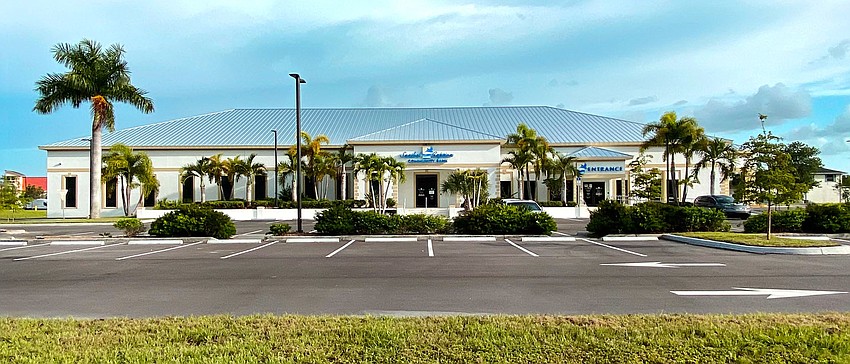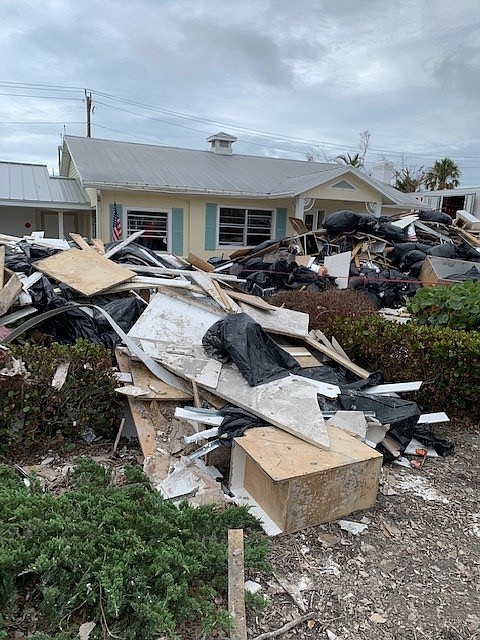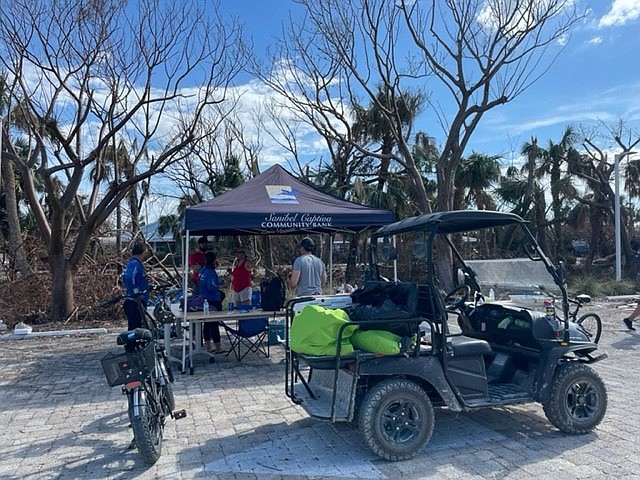- April 20, 2025
-
-
Loading

Loading

Kyle DeCicco expected to chat about banking when he met Sanibel Captiva Community Bank President and CEO Craig Albert for lunch in early 2016. A commercial loan officer then in his early 30s, DeCicco was eager to learn about how Albert built Sanibel Captiva, known as SanCap, into one of the top-performing small community banks nationwide.
Albert, instead, wanted to talk about swimming when the pair sat down at Cru at Bell Tower Shops in Fort Myers
Not recreational swimming, But DeCicco’s competitive swimming career, first at Fort Myers High School, then on scholarship to Florida Atlantic University in Boca Raton and then a tryout for the 2008 U.S. Olympic team. (DeCicco didn’t make the squad.) “I like hiring people who have competed in sports,” Albert says. “I think that’s a good trait in bankers.”
They eventually talked banking, and a short while later Albert offered DeCicco a job, as a vice president and commercial loan officer. DeCicco took the position, and seven years and a few promotions later, in a step both bankers say never came up that day at lunch, he’s now president and CEO-in-waiting for SanCap. “He’s really smart and a really great banker,” the soon-retiring Albert says, “but I love that he’s just a great person.”
Albert originally announced he would retire by the end of 2022, stepping back to being only board chairman. He recently postponed his retirement to June 30, saying there was more work he wanted to do post-Hurricane Ian, especially on Sanibel, where he co-founded the bank in 2003. Ravaged by the storm, Sanibel, 12 miles long and three miles wide at some points, is a curvy barrier island 20 miles southwest of Cape Coral with 6,500 people pre-Ian. The island, according to the Sanibel-Captiva Island Chamber of Commerce, had 564 open brick and mortar businesses before Ian, a tally that omits virtual entities like photographers and wedding planners. Some six months after Ian, in mid-April, that number had dwindled to 56 open businesses.
Albert, 63, is retiring not only because he and the board believe in DeCicco, but for personal health reasons: He had a brain tumor removed at the Mayo Clinic and was recently treated for atrial fibrillation. “I’ve been really beat up the last six or seven years,” he says, adding he has grandkids he wants to see more of, in both Fort Myers and Utah. “I needed to step back.”
DeCicco, 38, takes the helm of SanCap during a push-and-pull time for the bank, with $732 million in assets through Dec. 31, according to Federal Deposit Insurance Corp. data.

One of the few remaining locally based community banks in Southwest Florida, the push isn’t only from the standard grow-or-die mantra in banking, but to help Sanibel and Fort Myers-area businesses post-Ian. To wit, though early 2023, the bank had loaned more than $30 million for Ian recovery, in everything from construction rehab and rebuild projects to lines of credit for condo and homeowners associations. It also had donated well over six figures to a variety of community nonprofits.

To facilitate even more Ian recovery lending, on March 30 SanCap finalized a stock offering, for existing shareholders, that raised an additional $6.6 million. “Our capital raise will ensure that we can continue to help those impacted by the storm and help rebuild our community,” DeCicco says.
The pull, on the other hand, comes from the bank’s strategy to grow slow and steady and maintain higher profit and efficiency margins. As it is, S&P Global Market Intelligence has consistently ranked SanCap among the top 2% best-performing community banks nationwide out of more than 4,400 banks with assets under $1 billion. “Our plan of smaller growth might be harder to maintain,” Albert says, given the post-Ian demand in its core markets.
DeCiccio understands that internal battle. Yet, especially when it comes to helping post-Ian, he talks like the competitive former college athlete Albert had lunch with seven years ago. “We have a fiduciary responsibility to our community to win,” DeCicco says. “If we don't, this community cannot be rebuilt.”
People inside and outside SanCap are confident DeCicco, who mixes boyish enthusiasm and an aw-shucks demeanor with a serious, problem-solving, numbers-driven mind, is the right person for the job.
“He’s a real strategic thinker who is also personable.” says Brandon Box, Southwest Florida market president for Orlando-based Cogent Bank, who worked with DeCicco at IberiaBank a decade ago. Back then both young bankers worked on solving some intricate loan problems when IberiaBank assumed the assets and deposits of shuttered Naples-based Orion Bank. Box was impressed with how DeCicco handled the people side of the equation, not just the loan workouts. “You could tell a lot about people on how they handle the tough times.”
The son of a U.S. Secret Service agent. DeCicco recalls three valuable lessons in the changeover from Orion to IberiaBank.
One is how to interact with customers in difficult times and analyze risk that doesn’t show up on a spreadsheet. “Lending on character,” he says, “is sometimes better than lending on cash flow.”
Another lesson? Market forces always win the day. “You can’t underwrite appropriately to the fact that the market is going to crash,” he says, noting his first job was with Orion. ”No one can do that.”
The third lesson — something he uses often today, in a variety of interactions — is to get comfortable making decisions not everybody is going to like or agree with. For a personable polo-shirt wearing community banker, playing against type of the suit-wearing, party of no banker, that’s not always a cinch. “Sometimes it’s hard to make the right decision,” he says, “but you have to do the right thing all the time.”
DeCicco had two short stints at other community banks in the Fort Myers area after IberiaBank, leading to lunch with Albert. The pair was introduced by mutual friend, Jack Thomas, a Fort Myers wealth management executive who was a high school and college swimmer, like DeCicco.
Meeting and engaging with Albert was eye-opening for DeCicco. He saw not only a potential mentor in Albert, but in SanCap he saw a place where he wouldn’t have to worry about multiple management layers to get decisions made. “I saw I could advocate for my customers,” DeCicco says.
DeCicco embraces that ideal. One example: He gives his cellphone number to everyone. Most don't call, especially with one-off issues. But on a recent Sunday, while DeCicco was in church with his wife and two children, an attorney and SanCap customer called. The attorney couldn’t get his ATM card to work, and DeCicco talked him through the problem.
That disposition is also why DeCicco’s office is front and center in the bank’s main Fort Myers location. The bank has eight locations, two in Sanibel and six in Fort Myers. “I want to be in the lobby to greet customers,” he says “I don’t want to be in some corner office in the back.”
DeCicco acknowledges it might be corny, but he relishes the part of being a bank president when he gets “to change people’s lives.” That could be a loan for a customer, or in many cases, SanCap’s 104 employees. He cites two recent increases in the bank’s minimum wage, from $12 to $15 to $20 an hour. That was both a competitive move to stay close to bigger banks with bigger budgets andto reward staff. (More than 60% of SanCap’s employees are current bank shareholders, a point of pride for executives.) “We’re always looking for ways to take care of employees better,” he says. “They are the backbone of what we do.”
Individually, he cites an example of how he recently trained a commercial loan officer, who started with SanCap as an entry-level employee. “She’s now making 10 times what she did when she started,” he says.

Big picture, the bank’s growth focus, even if it’s slower in the mold of Albert’s plan, will be mostly on Ian recovery. DeCicco says he’s hearing from real estate brokers that land prices are getting back to pre-pandemic rates, and buyer interest is strong. That includes some potential foreign buyers paying into the tens of millions of dollars in places like Fort Myers Beach. “There will be lending and development opportunities for a decade,” DeCicco says, particularly in barrier island and beachfront locations.
There’s also the rebuilding of two SanCap branches on Sanibel Island, both at different points of the main road, Periwinkle Way. Combined that’s an $5 million investment, says DeCicco. The McGregor branch in Fort Myers is also being rebuilt.
With all this going on, there are also a host of anxieties DeCicco has, many out of his control. That includes inflation, which impacts customers and employees in different ways; insurance, which impacts deal opportunities in real estate; and the ongoing threat of supersized credit unions, which, many bankers argue, provides an unfair competitive advantage over banks due to not paying federal taxes.
One worry both DeCicco and Albert say they don’t have is selling to or merging with a bigger bank. The pair — they talk or text once a day and grab lunch together once a week — realize industry consolidation is a trend with staying power. That’s mostly because banks of all sizes look to fend off inflation and higher interest rates with efficiencies of scale. But SanCap hasn’t — and its leaders promise it never will — shown up in a merger announcement. ”This bank will not be sold,” DeCicco says. “That is not in the plans.”

Expanding outside Southwest Florida is also highly unlikely, given DeCicco asks, “why should I look to open on the East Coast or in the Panhandle, when I have all the business I can handle right here?”
DeCicco and Albert, in separate interviews, say they envision a similar transition in 2053 like what’s happening in 2023. “My expectation is that I will work the next 30 years here and then hand it off to someone else,” DeCicco says, “just like Craig did.”
Albert agrees, with a message that’s both a joke and warning for his mentee and protegee to stay the course. “Kyle’s not going to sell the bank,” Albert says. “Because he knows if he does I will kill him.”
| 2021 | 2022 | % Change | |
|---|---|---|---|
| Total interest income | $26.94M | $30.54M | 13.36% |
| Non interest income | $3.81M | $3.57M | -6.29% |
| Revenue | $30.75M | $34.11M | 10.92% |
| Assets | $728.8M | $732.02M | 0.44% |
| Tier 1 Risk Based Capital Ratio | 11.08% | 9.48% | N/A |
| Net interest margin | 3.71% | 4.19% | N/A |
| Return on assets | 1.3% | 1.44 | N/A |
Note: For a bank to generally be considered well-capitalized, regulators expect a Tier I capital ratio of at least 6%. Also, the average net interest margin for all banks, according to FDIC data, was 3.14% through Dec. 31. Prior to the pandemic, the average was over 3.25%. Return on assets measures how efficient a bank is at using assets to generate earnings. A bank can traditionally be sold for more than its tangible book value if it has an ROA of at least 1.3%.
Source: FDIC